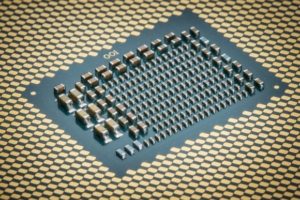Chip giant Intel (NASDAQ: INTC) has made it clear that it aims to cut its operating expenses to 30% of its revenue by no later than 2020 and, as of its most recent earnings report, it expects to hit that goal a year early.
To reduce operating expenses as a percentage of revenue, Intel is trying to cut operating expenses in addition to growing its overall revenue base.

Intel made significant progress in 2017, bringing its operating expenses as a percentage of revenue down to 32.8% from 35.6% the year before. During the year, Intel’s research and development (R&D) spending grew by just $358 million, a slowdown from the $612 million increase that it saw there during 2016.
More than offsetting that slight increase in R&D spending, though, was a decrease in marketing, general, and administrative (MG&A) spending to the tune of $923 million — an 11% cut.
Let’s go over how Intel did it.
Divesting McAfee
In 2011, Intel acquired anti-virus software company McAfee. Though executives promised that this acquisition would lead to significant synergies between McAfee’s products and future Intel processors, nothing significant came from this collaboration. After keeping McAfee, later renamed Intel Security Group (ISecG), for about five years, Intel decided to spin it off and retain a 49% stake.
This means that Intel no longer includes McAfee’s financial performance in its operating results. This brought both a deduction in revenue as well as a deduction of McAfee’s operating expenses, which partly explains Intel’s MG&A decline.
Changing up the Intel Inside program
Last year, Intel announced that it would be changing its co-marketing program (also known as the Intel Inside program). You can read about that change in detail here, but here’s a simplified explanation: Previously, Intel would reimburse its partners for marketing expenses incurred by those partners in trying to sell Intel products. That reimbursement would show up as an operating expense.
Under the new agreement, any such reimbursement would show up as a deduction from the revenue that Intel recognizes from the sale of the products covered by the co-marketing agreement.
In other words, Intel’s MG&A expenses come down significantly, but it doesn’t come for free — it shows up as a corresponding reduction in Intel’s revenue, as well.
An offset
The $923 million reduction in Intel’s MG&A spending is a net reduction, meaning more than that was cut, but part of that was offset by increases elsewhere.
Per Intel, the decline in MG&A from the factors described above were partly offset by “profit-dependent compensation due to an increase in net income, excluding Tax Reform impacts.”
In other words, because Intel made more money in 2017 than it did in 2016, any bonuses and other similar expenses that are tied to the profit that Intel makes grew year over year. This isn’t anything unusual; many companies implement similar bonus/profit-sharing schemes as another way to incentivize employees to want to see the company succeed.


